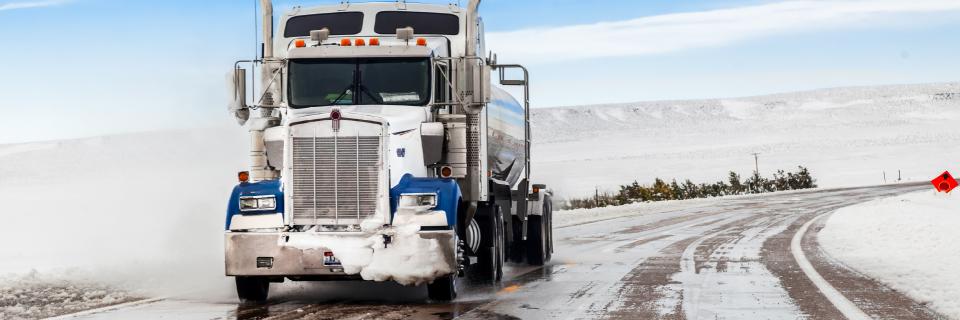
Winter is quickly approaching, which means now is the time to prepare your truck for winter safety. Cold weather can be hard on your truck’s engine and other vehicle components, which can be dangerous while you’re on the road. For those driving from a warmer climate to a cold climate, it’s important to prepare your truck for winter so you’re not left with a high maintenance bill from servicing a truck that has frozen over.
Here are 11 winter safety tips to help you begin preparations for driving during the cold season.
1. Avoid Parking Your Truck in the Cold for More Than 24 Hours
Whenever possible, avoid leaving your truck out in the cold for long periods of time. This can cause what is known as an engine cold soak. The components and fluids in the engine begin to freeze, and it may take a while to get the truck warmed up again if it has been sitting for more than a day.
2. Maintain Good Tire Health
It’s important to check tire pressure throughout winter since cold weather can decrease tire pressure. Low tire pressure means that rolling resistance will increase and your fuel economy will decrease. You should also keep an eye on the tire treads because low tread will decrease traction. This is worsened by icy and snow-covered roads, but switching to snow tires or using chains can help. Ensure that your tires receive regular balance and alignment checks.
3. Use an Engine Block Heater in Extreme Winter Temperatures
Before the temperature drops below zero degrees Fahrenheit, it’s time to plug in the engine block heater. This helps the oil in the engine block maintain fluidity so the truck will run more efficiently. If the oil begins to congeal due to low temperatures, the engine has to work harder since the oil isn’t moving properly. In this case, the truck will use more fuel and produce more emissions. To be proactive, once the temperature hits five degrees Fahrenheit, it’s a good idea to start using the engine block heater. Ensure that your engine block heater remains functional with proper maintenance checks.
4. Make Sure All Lights are Functional
Check that all lights are functional and replace those that are no longer working. You want to ensure visibility on dark, snowy days.
5. Check Your Battery
Your battery will need to work harder to function alongside a cold engine, and too much heat from overworking can damage the battery. Cold weather makes the battery drain quickly and makes it harder to charge. Before winter hits, make sure your battery is not past its expiration date. You need it in optimal condition to hold a charge, and you’ll also want to clean the connections regularly to keep the battery functioning properly.
6. Keep at Least Half a Tank of Winterized Fuel
A half-full tank can prevent condensation from building up in the tank itself, which then keeps fuel lines from freezing in cold temperatures. Also, if you’re ever broken down, stranded or stuck in traffic, you’ll have half a tank of fuel to keep your truck running and to keep you warm.
Winterized or seasonally-enhanced fuel will help your engine run in extreme cold weather. This type of fuel prevents fuel gelling, frozen fuel lines and blocked filters from build-up during the winter season. Winterized fuel can handle temperatures as low as -30 degrees Fahrenheit and helps maintain better fuel economy than using regular diesel in cold weather.
7. Inspect Your Windshield Wiper Blades
The beginning of winter may be the best time to have your windshield wipers replaced. You’ll need your wiper blades to function at peak performance since they’ll be wiping away freezing rain, sleet, snow and ice build-up.
8. Check Fluid Levels
The fluids that need to be measured during winter safety checks are engine oil, brake fluid, transmission fluid, coolant, power steering fluid and windshield washer fluid. Make sure these fluids are topped off before you begin your winter driving. Your fuel economy can be impacted if your fluids aren’t replenished regularly. It’s also important to keep water out of your fluid systems since water will freeze and cause problems.
9. Remove Ice and Snow from Your Truck
Built up ice on your rig can fall off during travel and cause damage to the cars behind you. The best winter safety practice is to remove all snow from your cabin roof, trailer and other parts of your truck where snow has settled. Many states have a law requiring you to remove snow from your truck before travelling to avoid becoming a winter safety hazard.
10. Check Your Brakes
It’s important to ensure that your brakes are working as they should, especially if you have air brakes, which are vulnerable during cold weather. Any moisture in the air system can freeze and prevent your truck from stopping properly.
11. Check Your Defrost and Heat
Ensure that your HVAC system’s defrost and heat are keeping up with the chill for those bitterly cold days. Heat and defrost are important to keep you warm and to keep your windows clear before getting on the road in cold weather.
Don’t just rely on these tips for winter safety; always take your truck to be serviced by professionals to get it ready for the cold weather. If you will be driving in cold weather for long periods of time, make sure you regularly keep an eye on the items mentioned in these winter safety tips. We want all drivers to be safe on the road and winter ready.
If you’re looking for more winter safety tips, or to learn more about other services offered by our family of brands, contact RTS today!